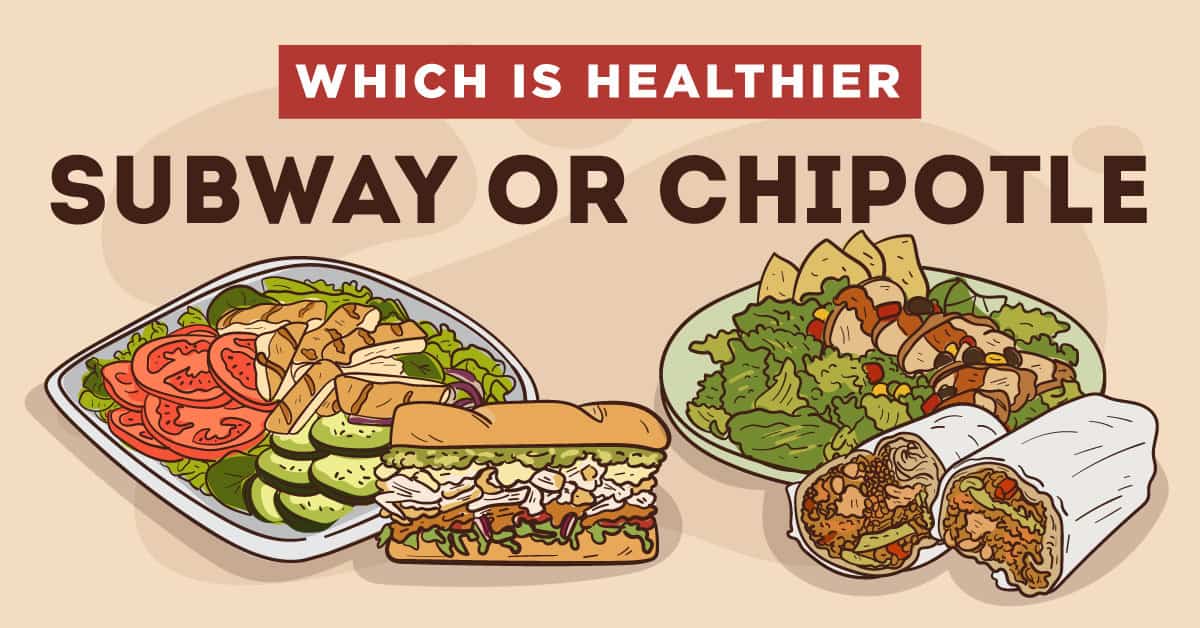Subway and Chipotle are two highly customizable fast food restaurants, but knowing which one is healthier is important.
As a nutrition coach, here’s my quick answer:
- Based on our 6 criteria of what makes a “healthy fast food choice”, Subway is slightly healthier than Chipotle.
- With that said, both Subway and Chipotle are healthier options compared to many other fast-food restaurants.
- Eating at either restaurant will be fine so long as you’re choosing the right menu options (I give you some healthy options below).
Subway vs Chipotle: Overview
Subway
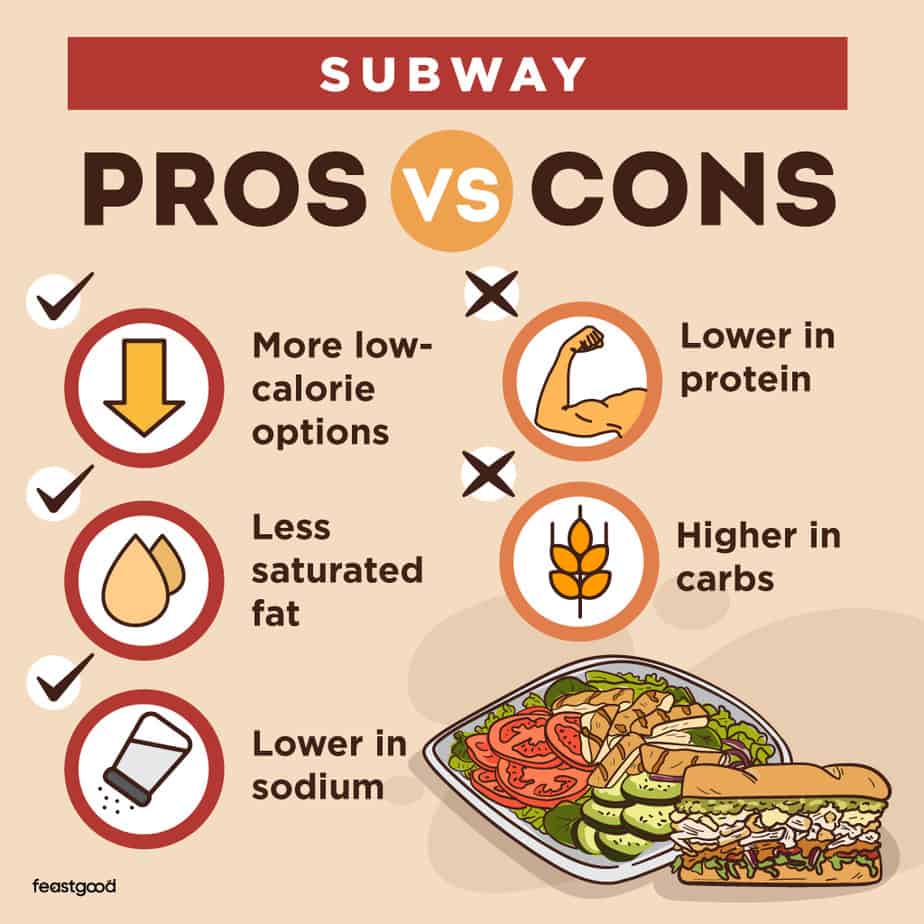
Subway specializes in subs, wraps, salads, protein bowls, and breakfast. However, for this article, I will leave out the breakfast options as they are less comparable to Chipotle’s menu items.
Subway’s meals are customizable, so you can choose your carb source, protein source, vegetables, sauces, and flavor enhancers (fat sources like oil and other sauces you’d put on top of your meal).
The average menu item from Subway has 511 calories, 22 grams of protein, 5.3 grams of saturated fat, 62 grams of carbs, and 1120mg of sodium.
Pros
- More low-calorie options
- Less saturated fat
- Lower in sodium
Cons
- Lower in protein
- Higher in carbs
If you’re wondering how to fit Subway meals into your daily calorie budget, check out What to Eat at Subway When Bulking or Cutting (6 Meals).
Chipotle
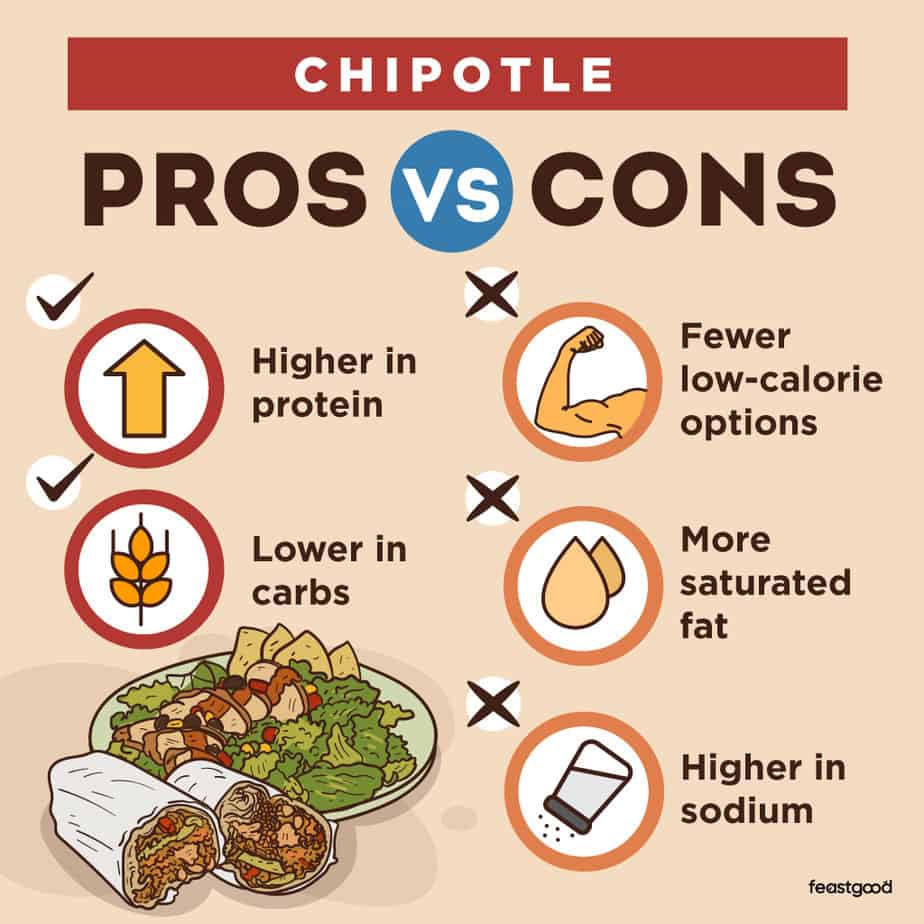
Chipotle specializes in burritos, burrito bowls, tacos, salads, and lifestyle bowls, which are all based on carb, protein, vegetable, and fat sources.
Chipotle’s meal options are completely customizable (like Subway), so you can decide which combinations of ingredients you’d like in your meal.
The average menu item at Chipotle has 766 calories, 28 grams of protein, 7.6 grams of saturated fat, 56 grams of carbs, and 2010mg of sodium.
Pros
- Higher in protein
- Lower in carbs
Cons
- Fewer low-calorie options
- More saturated fat
- Higher in sodium
For examples of meals, you can make at Chipotle when trying to lose weight or build muscle, check out What To Eat At Chipotle When Bulking or Cutting (6 Meals).
Comparing Subway & Chipotle: Which Is Healthier?
To determine whether Subway or Chipotle is healthier, I’ve compared them across different nutritional categories to see which one comes out on top.
Check out more restaraunt comparisons on our Fast Food Fitness page where we explore how to stay on track with your goals while on-the-go.
Low-Calorie Options
Both Subway and Chipotle have plenty of low-calorie options because their meals are based around a carb source, a protein source, vegetables, and flavor enhancers. Therefore, you’re generally getting a balanced meal.
However, Subway has more low-calorie options than Chipotle. The average calorie content of Subway’s menu items is 511 calories, and the average calorie content of Chipotle’s menu items is 766 calories.
Although the menu items from each chain are generally considered healthy, the menu items from Subway are lower in calories.
The Winner: Subway
- Subway’s menu items have 255 fewer calories than Chipotle’s menu items on average. Therefore, Subway has more low-calorie options than Chipotle.
Saturated Fat Content
Both Subway and Chipotle are fast food restaurants that are lower in saturated fat. Subway’s menu items have less saturated fat than Chipotle’s menu items, with an average of 5.3g compared to 7.6g, respectively.
The American Heart Association (AHA) recommends limiting your saturated fat intake to 5-6% of your total calories. Assuming an intake of 2000 calories per day, this would allow for 100-120 calories at most from saturated fat per day.
Subway’s menu items would give you an average of 48 calories from saturated fat, and Chipotle’s would provide an average of 68 calories from saturated fat.
The higher content of saturated fat from Chipotle is from a wider variety of proteins that are higher in saturated fat, including steak, carnitas, and barbacoa.
These proteins are typically paired with cheese, which has 5g of saturated fat per serving, and guacamole, which has 4g of saturated fat per serving.
The combination of fattier protein sources, cheese, and guacamole makes Chipotle’s menu items higher in saturated fat than Subway’s menu items.
The Winner: Subway
- Although both restaurants have menu items that fit within the AHA’s recommendations, Subway’s menu items are lower in saturated fat by an average of 2.3g.
Protein Content
Protein is important to determine whether Subway or Chipotle is healthier because it helps to keep you satiated, maintain muscle, and build additional muscle.
Subway’s menu items have an average of 22g of protein, whereas Chipotle’s menu items have 28g of protein.
Subway’s highest protein menu item is the Chicken & Bacon Ranch Protein Bowl with 55 grams of protein. Tthe lowest is a Veggie Delight Salad with 3 grams of protein.
Chipotle’s highest protein menu item is the Chicken Burrito (with brown rice, black beans, cheese, guac, and salsa) with 63 grams of protein. The lowest is a Veggie Salad with 3 grams of protein.
The Winner: Chipotle
- Chipotle is higher in protein than Subway (+6g), so it is the better option to help you meet your daily protein goals.
Carb Content
Subway’s menu items have an average of 62g of carbs, with the highest being the wraps and the lowest being the salads. Chipotle’s menu items have an average of 56g of carbs, with the highest being the burritos and the lowest being the salads.
The higher carb content of Subway’s menu items is to be expected since most of its meals contain either a wrap or a sub roll. On the other hand, Chipotle specializes in burritos, tacos, and rice bowls, which have fewer carbs than a sub roll.
The quality of carbs at Chipotle is also higher than the quality of carbs at Subway. Chipotle has multiple high-fiber carb options like brown rice, beans, and whole grain tortillas. Subway’s only high-quality carb is its multigrain bread.
The Winner: Chipotle
- Chipotle has fewer carbs than Subway (-6g) and more high-quality, high-fiber carb options. It is the better option if you’re looking to reduce your carb intake and increase your fiber intake.
Sodium Content
Subway’s menu items have an average of 1120mg, whereas Chipotle’s menu items have an average of 2010mg of sodium (+890).
These are both higher than the recommended 1200-1500mg of sodium per day, but because they’re customizable, you can easily make them lower in sodium.
For example, at Chipotle you can customize your order to reduce your sodium content by skipping the salsa. At Subway, you can choose a lower sodium protein source like the chicken strips (210mg).
The main reason why Chipotle’s menu items have more sodium than Subway’s is because of the amount of sodium in its guacamole and salsas, which are generally added to all menu items.
Chipotle’s guacamole has 370mg of sodium, and its salsas have an average of 410mg. If you’re having both, you’re increasing the meal’s sodium content by approximately 780mg.
For low-sodium meals at Chipotle, check out these 12 options.
The Winner: Subway
- Subway’s menu items have a lower average amount of sodium than Chipotle’s menu items. However, if you skip the guacamole and salsa at Chipotle, the two restaurants would be similar in their sodium content.
Variety of Nutrients
Subway and Chipotle both have more nutrients than many other fast-food restaurants because you get to build your own meal. Therefore, you have a variety of options to choose from.
Subway has 21 different protein options available to add to your meal, such as chicken, steak, veggie patties, and deli meats like ham and turkey. Chipotle only has 7 different protein options, including chicken, beef barbacoa, pork carnitas, steak, and sofritas (plant-based protein).
Subway has 9 different vegetables that you can add to your meal including lettuce, tomato, cucumber, pickles, green pepper, banana peppers, onion, spinach, and jalapeno. Chipotle only has 2 vegetables to choose from: lettuce and fajita veggies (which are a mix of bell peppers and onions).
Subway has 3 different carb options: bread, flatbread, and wraps. Chipotle has 4 different carb options: tortillas, rice, beans, and corn chips.
Both Subway and Chipotle have the same fat sources: cheese, avocado, and various salad dressings.
The Winner: Subway
- Although both restaurants have fresh ingredients that add nutrients to your meal, Subway has significantly more protein and vegetable options to choose from. Therefore, it has a wider variety of nutrients to offer.
Most Popular Meals: Head To Head Comparison
Subway MexiCali vs Chipotle Steak & Avocado Burrito
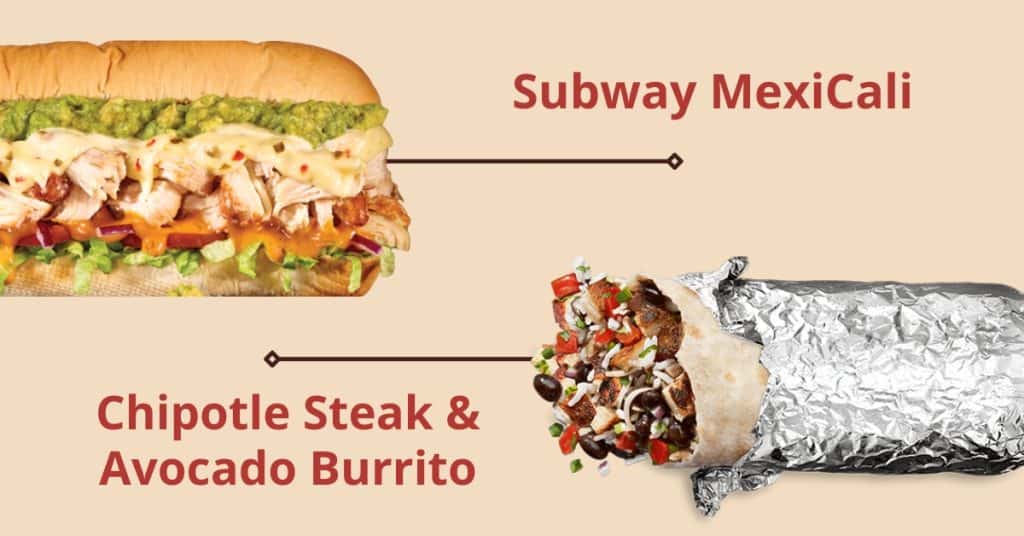
Two similar menu items at Subway and Chipotle are Subway’s MexiCali Sub (with smashed avocado) and Chipotle’s Steak & Avocado Burrito.
The Subway sub is served on Italian bread with veggies and southwest chipotle sauce. The Chipotle burrito can be created by ordering a burrito with steak, avocado, fajita veggies, and salsa.
| Nutrition | Subway MexiCali Sub | Chipotle Steak & Avocado Burrito |
|---|---|---|
| Calories | 500 calories | 750 calories |
| Protein | 29g | 32g |
| Carbs | 40g | 68g |
| Total Fat (Saturated) | 27g (9g) | 37g (7g) |
| Sodium | 1290mg | 1950mg |
Subway’s MexiCali Sub has fewer calories, carbs, total fat, and sodium than Chipotle’s Steak & Avocado Burrito. However, Chipotle’s burrito has more protein and healthy fats (unsaturated fats) than Subway’s sub.
The Winner: Subway
- Subway’s sub is better in almost all nutritional aspects, so it is the healthier choice when compared with Chipotle’s burrito.
Subway Veggie Patty Salad vs Chipotle Sofritas Salad
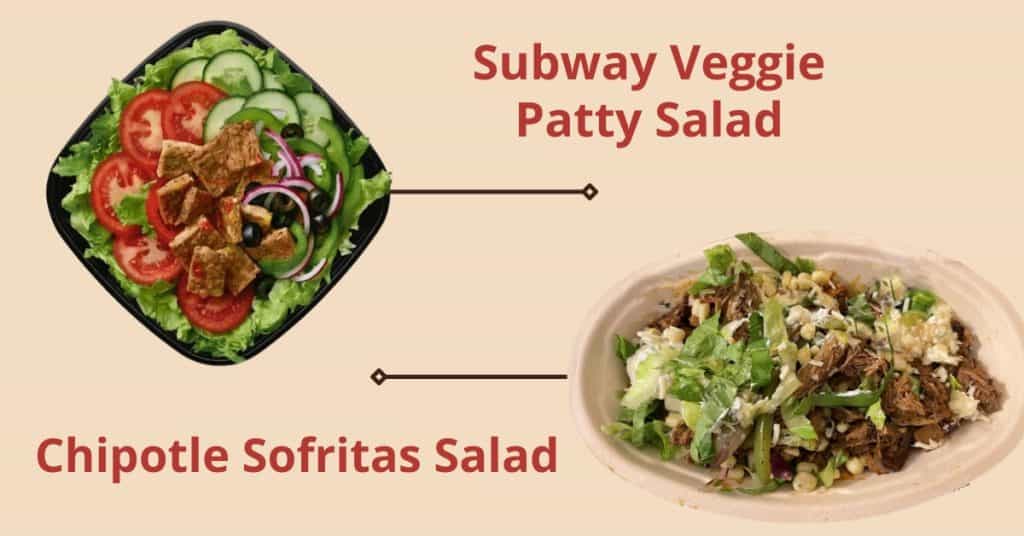
Subway’s veggie patty salad is made by adding a veggie patty to the Veggie Delight salad. Chipotle’s Sofritas Salad can be made by ordering a salad and adding sofritas, fajita veggies, and chipotle-honey vinaigrette.
| Nutrition | Subway Veggie Patty Salad | Chipotle Sofritas Salad |
|---|---|---|
| Calories | 320 calories | 417 calories |
| Protein | 9g | 15g |
| Carbs | 26g | 33g |
| Total Fat (Saturated Fat) | 20g (5g) | 25g (4g) |
| Sodium | 390mg | 1560mg |
Subway’s veggie patty salad has fewer calories, carbs, total fat, and much less sodium than Chipotle’s sofritas salad. The main benefit of Chipotle’s Sofritas Salad is its higher protein content, which can help keep you full for longer.
The Winner: Subway
- Overall, Subway’s Veggie Patty Salad has more nutritional benefits than Chipotle’s salad.
However, if you struggle to meet your protein targets, choose the Chipotle Sofritas Salad instead.
Subway Grilled Chicken Salad vs Chipotle Chicken Salad
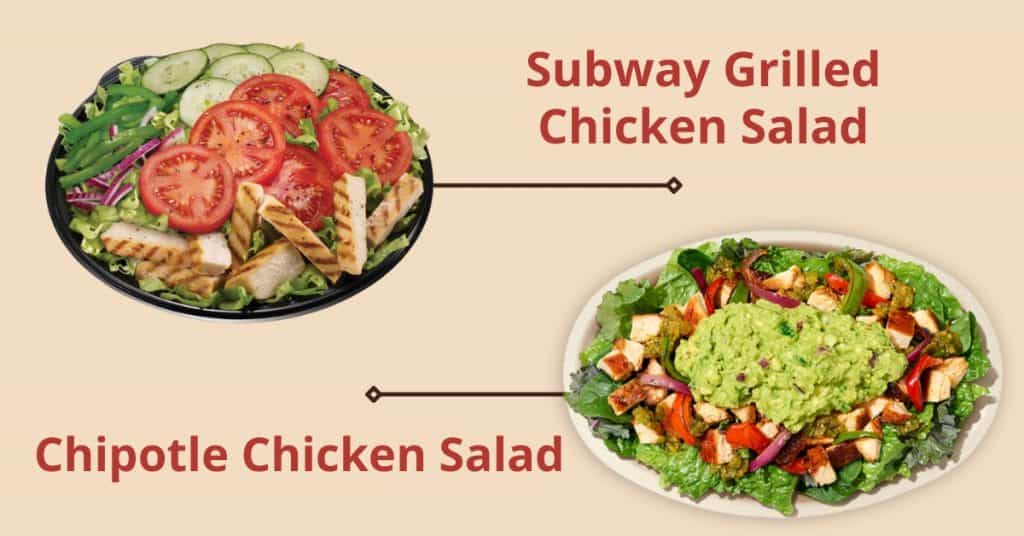
Subway’s Grilled Chicken Salad is served with lettuce, spinach, tomatoes, onions, green peppers, cucumbers, olives, and sweet onion dressing.
Chipotle’s Chicken Salad is served with a blend of kale, spinach, and lettuce with fajita veggies and a chipotle-honey vinaigrette.
| Nutrition | Subway Veggie Patty Salad | Chipotle Sofritas Salad |
|---|---|---|
| Calories | 145 calories | 425 calories |
| Protein | 14g | 34g |
| Carbs | 18g | 24g |
| Total Fat (Saturated Fat) | 2g (1g) | 23g (6g) |
| Sodium | 485mg | 1310mg |
Subway’s grilled chicken salad is lower in calories, carbs, fat, and sodium than Chipotle’s chicken salad. However, the salad from Chipotle is significantly higher in protein, so it would keep you full for longer.
That said, there is an option to order “double protein” at Subway to increase the amount of meat in your order. The double protein option at Subway would increase this salad to 28 grams of protein (and +56 calories), which is closer to the amount of protein in the Chipotle Chicken Salad.
The main difference between these salads is the salad dressings. Chipotle’s dressing is much higher in calories and fat than Subway’s dressing (220 calories & 16g of fat vs 35 calories & 0g of fat).
The Winner: Subway
- Subway’s menu items have 255 fewer calories than Chipotle’s menu items on average. Therefore, Subway has more low-calorie options than Chipotle.
Healthy Meal Options At Subway
My top 3 healthy meal recommendations from Subway are:
1. Sweet Onion Teriyaki Chicken Bowl
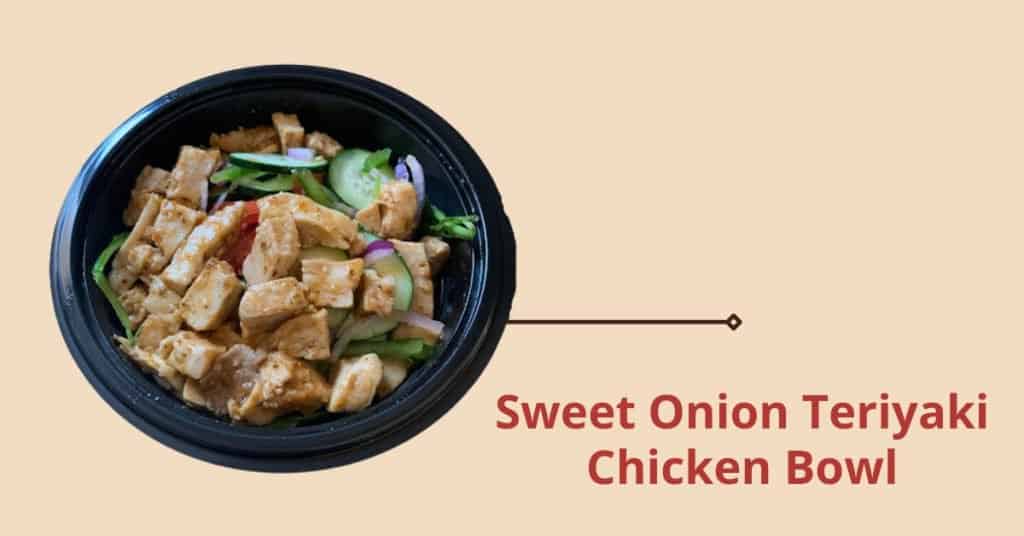
The Sweet Onion Teriyaki Chicken Bowl is a healthy option because you can load it with veggies for a nutrient boost, and it comes with a protein source (chicken).
This bowl has enough protein and fiber to keep you full, while also having enough nutrients to support your overall health.
This bowl has 330 calories, 34 grams of protein, 5 grams of fat, 41 grams of carbs, and 1090mg of sodium.
2. Buffalo Chicken Grilled Chicken Sub
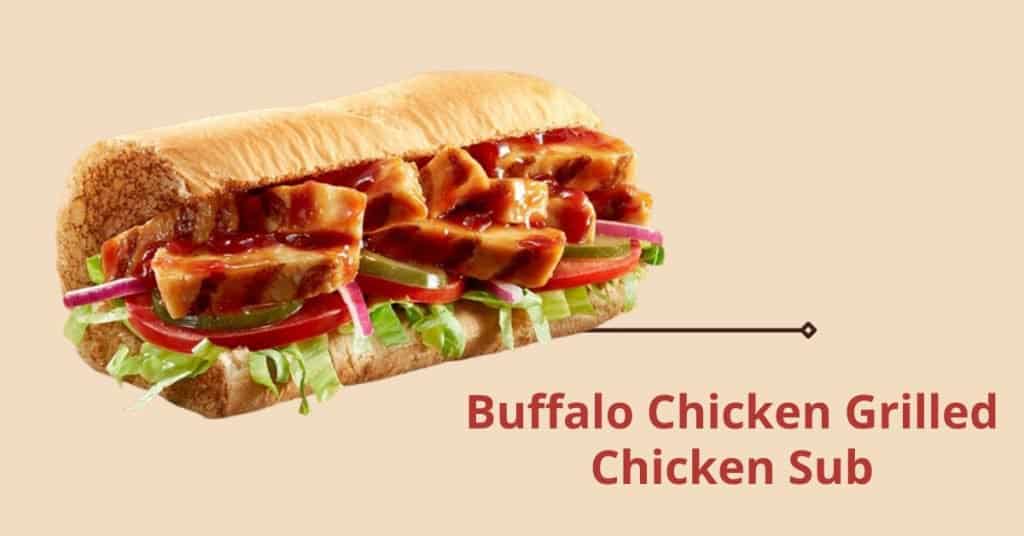
The Buffalo Chicken Grilled Chicken Sub is a healthy option because it’s packed full of protein and is low in fat compared to many other Subway subs.
The sandwich on its own, which is only served with grilled chicken marinated in buffalo sauce, doesn’t have enough nutrients, so it’s important to add veggies.
I recommend adding lettuce or spinach, green pepper, onion, and pickles (the buffalo sauce and pickle combo will not disappoint).
In total, this sub has 340 calories, 24 grams of protein, 12 grams of fat, 39 grams of carbs, and 1360mg of sodium.
If you prefer a lower sodium option, order a standard grilled chicken sub (210mg) instead of the buffalo chicken (900mg). This will help reduce the sodium content by 690mg of sodium.
3. Veggie Delite Salad (+ Chicken or Veggie Patty)
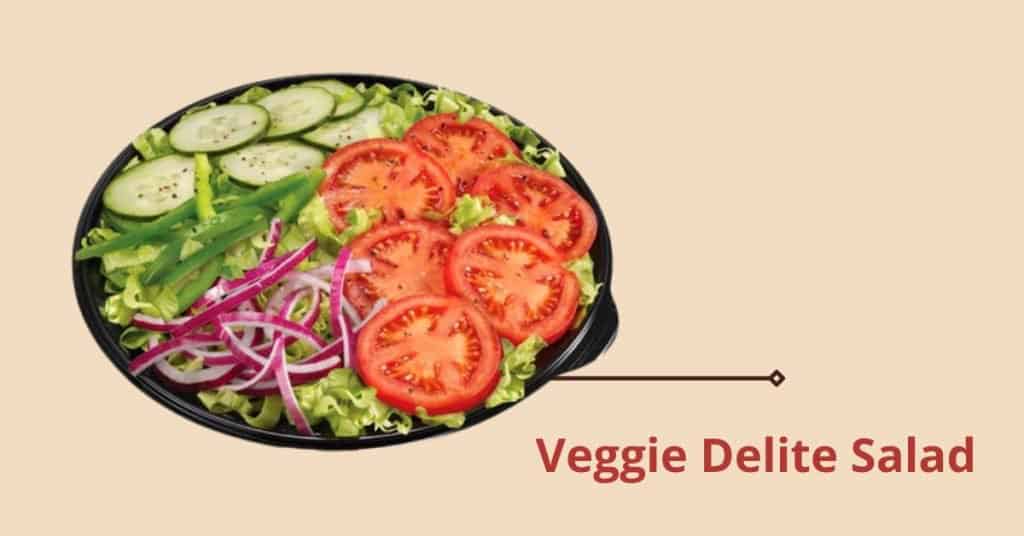
Another healthy meal option from Subway is the Veggie Delite Salad, which is loaded with veggies and avocado for healthy fats. However, the salad on its own only has 4 grams of protein, which is way too low.
For this reason, I recommend adding grilled chicken (+11g of protein) or two veggie patties (+12g of protein) to the salad to ensure you get an adequate amount of protein.
With the chicken, you get 254 calories, 15 grams of protein, 17g of fat, 14 grams of carbs, and 820mg of sodium.
With the veggie patties, you get 380 calories, 16 grams of protein, 26 grams of fat, 48 grams of carbs, and 900mg of sodium.
Read more about Subway:
- 8 Best Low Sodium Subway Meals
Healthy Meal Options At Chipotle
My top 3 healthy meal recommendations from Chipotle are:
1. Paleo Salad Lifestyle Bowl
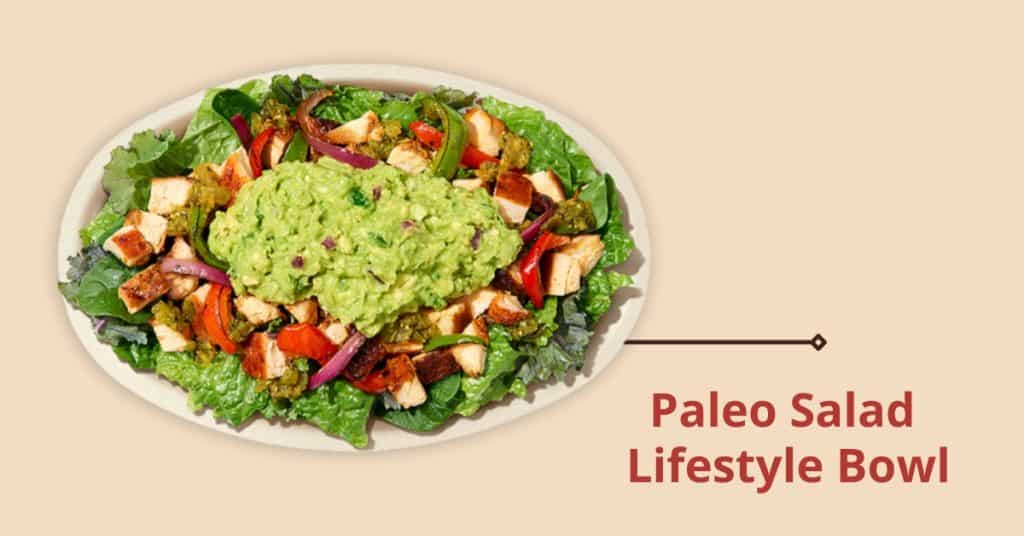
Chipotle’s Paleo Salad Bowl is a healthy option because it’s loaded with nutrients, protein, and healthy fats from the veggies, chicken, and guacamole.
You can eat this bowl as is because it has enough protein and fiber to keep you full and enough nutrients to support your overall health.
However, if you have been advised to reduce your sodium consumption, skip the salsa that comes with this bowl because it is higher in sodium (500mg).
This lifestyle bowl (salsa included) has 450 calories, 35 grams of protein, 29 grams of fat, 18 grams of carbs, and 1090mg of sodium.
2. Barbacoa Burrito Bowl
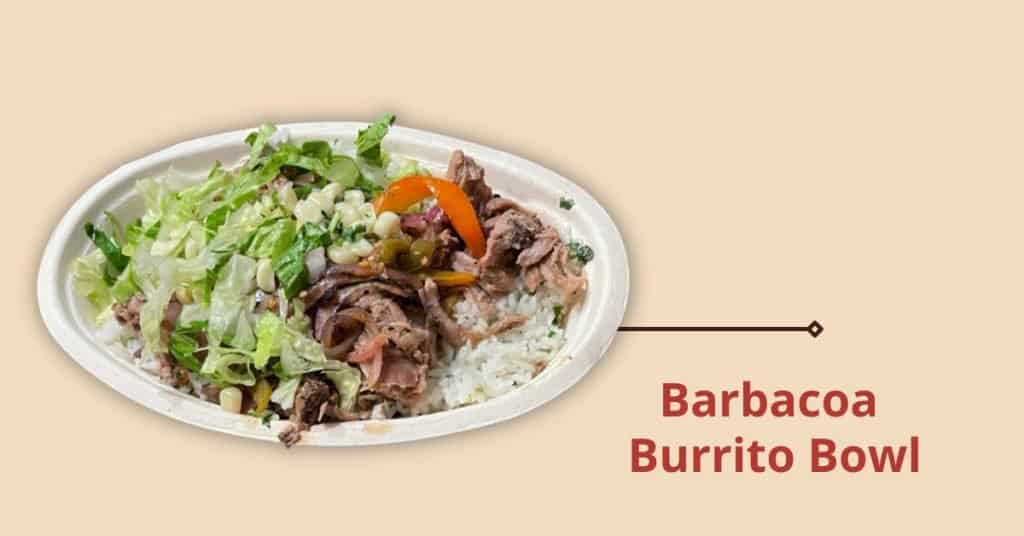
Another healthy option from Chipotle is a customized Barbacoa Burrito Bowl made with barbacoa, brown rice, black beans, fajita veggies, and “light” roasted chili-corn salsa (½ the normal amount).
If you have a higher carb allowance based on your goals, you could eat this burrito bowl as is. If you have a lower daily carb intake, you may want to ask for “light rice,” meaning less rice than usual.
For the regular bowl, you’d get 465 calories, 39 grams of protein, 15 grams of fat, 73 grams of carbs, and 1245mg of sodium.
For the “light rice” bowl, you’d get 570 calories, 37 grams of protein, 12 grams of fat, 55 grams of carbs, and 1150mg of sodium.
If this bowl is too high in sodium for you, skip the salsa to reduce the sodium by up to 500mg.
3. Three Chicken Fajita Veggie Tacos
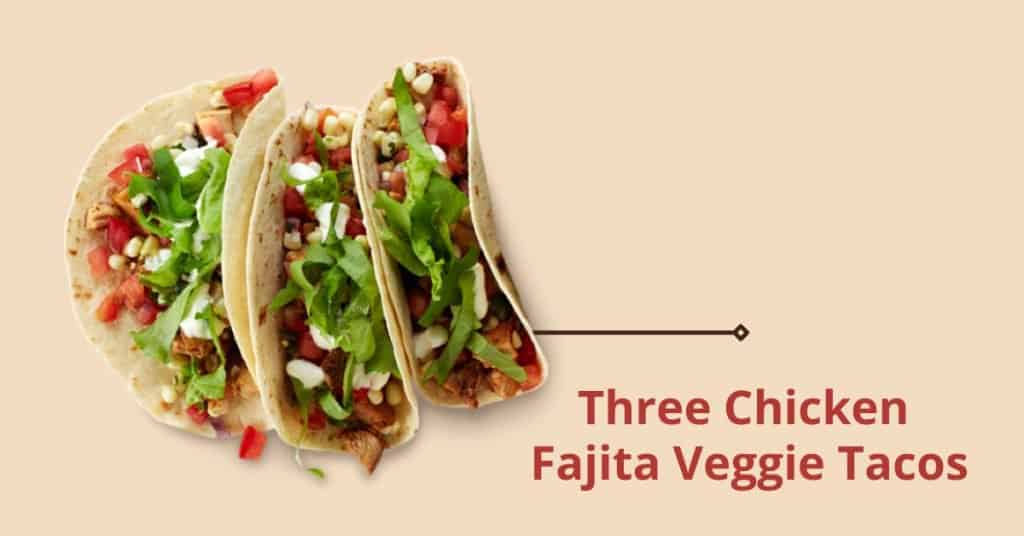
If you’re in the mood for tacos, the healthiest option at Chipotle is the Chicken Tacos with Fajita Veggies. You can add cheese as a source of fat to balance out this meal.
You could also add salsa or guacamole for flavor, but this would cost you around 250-500mg of sodium.
Without the salsa or guac, you could get all three chicken tacos for 400 calories, 36 grams of protein, 16 grams of fat, 34 grams of carbs, and 460mg of sodium.
Other Fast-Food Comparisons
About The Author

Amanda Parker is an author, nutrition coach, and Certified Naturopath. She works with bodybuilders, Olympic weightlifters, and powerlifters to increase performance through nutrition and lifestyle coaching.
Why Trust Our Content

On Staff at FeastGood.com, we have Registered Dietitians, coaches with PhDs in Human Nutrition, and internationally ranked athletes who contribute to our editorial process. This includes research, writing, editing, fact-checking, and product testing/reviews. At a bare minimum, all authors must be certified nutrition coaches by either the National Academy of Sports Medicine, International Sport Sciences Association, or Precision Nutrition. Learn more about our team here.
Have a Question?
If you have any questions or feedback about what you’ve read, you can reach out to us at [email protected]. We respond to every email within 1 business day.
